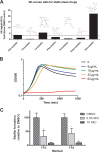A Drug Repositioning Approach Reveals that Streptococcus mutans Is Susceptible to a Diverse Range of Established Antimicrobials and Nonantibiotics
- PMID: 29061736
- PMCID: PMC5740335
- DOI: 10.1128/AAC.01674-17
A Drug Repositioning Approach Reveals that Streptococcus mutans Is Susceptible to a Diverse Range of Established Antimicrobials and Nonantibiotics
Abstract
Streptococcus mutans is the primary causative agent of dental caries and contributes to the multispecies biofilm known as dental plaque. An adenylate kinase-based assay was optimized for S. mutans to detect cell lysis when exposed to the Selleck library (Selleck Chemical, Houston, TX) of 853 FDA-approved drugs in, to our knowledge, the first high-throughput drug screen in S. mutans We found 126 drugs with activity against S. mutans planktonic cultures, and they were classified into six categories: antibacterials (61), antineoplastics (23), ion channel effectors (9), other antimicrobials (7), antifungals (6), and other (20). These drugs were also tested for activity against S. mutans biofilm cultures, and 24 compounds were found to inhibit biofilm formation, 6 killed preexisting biofilms, 84 exhibited biofilm inhibition and killing activity, and 12 had no activity against biofilms. The activities of 9 selected compounds that exhibited antimicrobial activity were further characterized for their activity against S. mutans planktonic and biofilm cultures. Together, our results suggest that S. mutans exhibits a susceptibility profile to a diverse array of established and novel antibacterials.
Keywords: Streptococcus mutans; antibiotics; dental caries; high-throughput screen.
Copyright © 2017 American Society for Microbiology.
Figures





Similar articles
-
Effects of Antimicrobial Peptide GH12 on the Cariogenic Properties and Composition of a Cariogenic Multispecies Biofilm.Appl Environ Microbiol. 2018 Nov 30;84(24):e01423-18. doi: 10.1128/AEM.01423-18. Print 2018 Dec 15. Appl Environ Microbiol. 2018. PMID: 30341079 Free PMC article.
-
A tooth-binding antimicrobial peptide to prevent the formation of dental biofilm.J Mater Sci Mater Med. 2019 Mar 30;30(4):45. doi: 10.1007/s10856-019-6246-6. J Mater Sci Mater Med. 2019. PMID: 30929087
-
Molecule Targeting Glucosyltransferase Inhibits Streptococcus mutans Biofilm Formation and Virulence.Antimicrob Agents Chemother. 2015 Oct 19;60(1):126-35. doi: 10.1128/AAC.00919-15. Print 2016 Jan. Antimicrob Agents Chemother. 2015. PMID: 26482298 Free PMC article.
-
Antibacterial effects of natural compounds on biofilm formation of Streptococcus mutans.Clin Exp Dent Res. 2022 Dec;8(6):1426-1433. doi: 10.1002/cre2.673. Epub 2022 Oct 25. Clin Exp Dent Res. 2022. PMID: 36281582 Free PMC article. Review.
-
[Research Progress on Drug Intervention to Inhibit Dental Plaque Biofilm Formation by Streptococcus mutans Based on the Concept of Ecological Prevention of Dental Caries].Sichuan Da Xue Xue Bao Yi Xue Ban. 2024 Nov 20;55(6):1597-1603. doi: 10.12182/20241160609. Sichuan Da Xue Xue Bao Yi Xue Ban. 2024. PMID: 39990851 Free PMC article. Review. Chinese.
Cited by
-
Medicinal Chemistry of Inhibitors Targeting Resistant Bacteria.Curr Top Med Chem. 2022;22(24):1983-2028. doi: 10.2174/1568026622666220321124452. Curr Top Med Chem. 2022. PMID: 35319372
-
In vitro Antibacterial Activity of an FDA-Approved H+-ATPase Inhibitor, Bedaquiline, Against Streptococcus mutans in Acidic Milieus.Front Microbiol. 2021 Feb 25;12:647611. doi: 10.3389/fmicb.2021.647611. eCollection 2021. Front Microbiol. 2021. PMID: 33717046 Free PMC article.
-
Drug Repositioning as a Therapeutic Strategy against Streptococcus pneumoniae: Cell Membrane as Potential Target.Int J Mol Sci. 2023 Mar 18;24(6):5831. doi: 10.3390/ijms24065831. Int J Mol Sci. 2023. PMID: 36982905 Free PMC article.
-
Non-Antibiotic Drug Repositioning as an Alternative Antimicrobial Approach.Antibiotics (Basel). 2022 Jun 17;11(6):816. doi: 10.3390/antibiotics11060816. Antibiotics (Basel). 2022. PMID: 35740222 Free PMC article. Review.
-
Gymnemic Acids Inhibit Adhesive Nanofibrillar Mediated Streptococcus gordonii-Candida albicans Mono-Species and Dual-Species Biofilms.Front Microbiol. 2019 Oct 11;10:2328. doi: 10.3389/fmicb.2019.02328. eCollection 2019. Front Microbiol. 2019. PMID: 31681200 Free PMC article.
References
Publication types
MeSH terms
Substances
Grants and funding
LinkOut - more resources
Full Text Sources
Other Literature Sources
Medical

